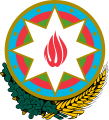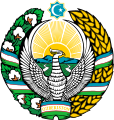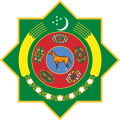Rub el Hizb
| ۞ | |
|---|---|
Rub el Hizb | |
| In Unicode | U+06DE ۞ ARABIC START OF RUB EL HIZB (HTML ۞) |
The Rub-el-Hizb (Arabic: ربع الحزب rubʿ al-ḥizb), also known as the Islamic Star, is an Islamic symbol. It is in the shape of an octagram, represented as two overlapping squares. It is has been found on a number of emblems and flags. The main purpose of this dividing system is to facilitate the recitation of the Quran.
Etymology[]
In Arabic, Rubʻ means "one-fourth" or "quarter," while Hizb translates to "a group." Initially, it was used in the Quran, which is divided into 60 Hizbs (groups of roughly equal length); Rub el Hizb further divides each Hizb in four. A Hizb is one half of a juz'.
History[]
Islamic archeologists investigations have shown that the Rub el Hizb symbol possibly originated from ancient petroglyphs in the Arabian desert. The symbol in question, consisting of two concentric circles with a defined punctual center, connected by eight radial sectors, is similar to the Islamic symbol when the two lines of the East-West orientation are combined, thus resulting in a hexagon with a circular symmetry.[1][irrelevant citation]
Contemporary use[]
Former flags[]

The first country to use the Rub-el-Hizb was Merinid in 1258.

Flag of Morocco (1258-1659)

Flag of Emirate of Afghanistan (1919-1926)
Current flags[]

Standard of the President of Turkmenistan

Standard of the President of Uzbekistan
Emblems[]

Emblem of Azerbaijan
See also[]
References[]
- ^ Majeed Khan (13 December 2013). "Rock Art of Saudi Arabia". Arts 2013, 2, 447-475 (Figure 28); doi:10.3390/arts2040447. Retrieved 11 May 2021.
- ^ Galal Abada (2004). "Petronas Office Towers" (PDF). Kuala Lumpur, Malaysia. Archived from the original on 2012-10-01.CS1 maint: unfit URL (link)
- Star symbols
- Islamic terminology
- Islamic symbols










